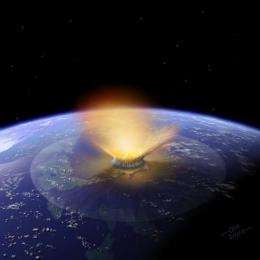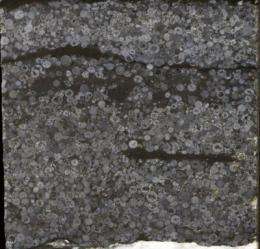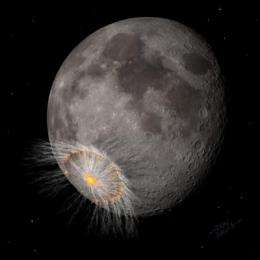Splatters of molten rock signal period of intense asteroid impacts on Earth

New research reveals that the Archean era — a formative time for early life from 3.8 billion years ago to 2.5 billion years ago — experienced far more major asteroid impacts than had been previously thought, with a few impacts perhaps even rivaling those that produced the largest craters on the Moon, according to a paper published online today in Nature.
The fingerprints of these gigantic blasts are millimeter- to centimeter-thick rock layers on Earth that contain impact debris: sand-sized droplets, or spherules, of molten rock that rained down from the huge molten plumes thrown up by mega-impacts. This barrage of asteroids appears to have originated in an extended portion of the inner asteroid belt that is now mostly extinct. Computer models suggest the zone was likely destabilized about 4 billion years ago by the late migration of the giant planets from the orbits they formed on to where we find them today.
The team conducting this study includes members or associates of the NASA Lunar Science Institute's Center of Lunar Origin and Evolution (CLOE), based at the Southwest Research Institute (SwRI) in Boulder, Colo.
Archean rocks are scarcer than rocks of any other age, and impact spherule beds have been found only in terrains where conditions were ideal for capture and preservation, such as in shales deposited on the seafloor below the reach of waves. At least 12 spherule beds deposited between 3.47 and 1.7 billion years ago (Ga) have been found, with most in the Archean; 7 between 3.23-3.47 Ga, 4 between 2.49-2.63 Ga and 1 between 1.7-2.1 Ga.
"The beds speak to an intense period of late bombardment of the Earth, but their source has long been a mystery," says CLOE Principal Investigator and SwRI Researcher Dr. William Bottke.

By comparison, the Chicxulub impact that is believed to have killed the dinosaurs 65 million years ago was the only known collision over the past half-billion years that made a spherule layer as thick as those of the Archean period.
"The Archean beds contain enough extraterrestrial material to rule out alternative sources for the spherules, such as volcanoes," says Bruce Simonson, a geologist from the Oberlin College and Conservatory who has studied these ancient layers for decades.
The timing of these major events is curious because they occur well after the presumed end of the so-called Late Heavy Bombardment, or LHB, of the Moon. This period occurred about 4 billion years ago and produced the largest lunar craters, or basins. The precise nature of the LHB continues to be debated, and testing what happened and for how long was the top science priority for future exploration of the Moon, according to a previously published report by the National Research Council.
The best available model of the LHB, often referred to as the Nice model after the observatory where it was developed in Nice, France, invokes a large-scale repositioning of the giant planets Jupiter, Saturn, Uranus and Neptune as a trigger for a solar system-wide bombardment of asteroids and comets. The extensive pummeling of the Earth and Moon identified in the Nice model, however, lasted 100- to 200-million years, not nearly long enough to explain the Archean spherule beds.

Following up on the implications of the Nice model, the team examined a possible missing source of impactors, one that would have come from the inner edge of the main asteroid belt between the orbits of Mars and Jupiter. While most of this region is now unstable, researchers believe this may not have been the case 4 billion years ago. The difference was that the giant planets, whose gravitational forces control the orbital stability of solar system worlds, were likely in a more compact configuration than they are now. By creating a hypothetical extension to the primordial asteroid belt and tracking what would have happened to these bodies when the giant planets reorganized themselves, team members found the bodies could have delivered numerous big impactors to the Earth and Moon over a much longer time. As additional validation of the model, team members found it could reproduce a tiny population of asteroids called the Hungarias, a reservoir of relatively stable but fairly small asteroids located between the orbits of Mars and the inner edge of the main asteroid belt.
They found that approximately 70 (and 4) dinosaur killer-sized or larger impacts hit the Earth (and Moon) over a span that lasted between 3.8 and 1.8 billion years ago. The frequency of these impacts was enough to reproduce the known impact spherule beds. It also hints at the possibility that the enormous 180-kilometer (112-mile) diameter Vredefort crater in South Africa, which is 2 billion years old, and the nearly 250-kilometer (155-mile) Sudbury crater in Canada, which is 1.85 billion years old, might be literally the last gasp of the LHB on Earth.
Team members predict that the largest Archean-era impacts should be similar to the 15 or so youngest and largest lunar basins, which range in diameter from about 300,200 kilometers (186-miles). The implication of such enormous impacts over the Archean era is unknown, but some are believed to have released nearly 500 times the blast energy of the Chicxulub impact.
"It will be interesting to see whether these mammoth events affected the evolution of early life on our planet or our biosphere in important ways," says Bottke.
In a companion paper also published online today in Nature, another team of researchers, led by Brandon Johnson and Jay Melosh of Purdue University, used computer models to estimate the gargantuan projectile sizes needed to explain the nature and distribution of the Archean spherule layers. Their work provides experimental data to correlate with this study.
More information: The article, "An Archaean Heavy Bombardment from a Destabilized Extension of the Asteroid Belt" appears in the May 3 issue of Nature.
Journal information: Nature
Provided by Southwest Research Institute




















